The Pantheus System is a star system located in the fringes of the Anthrov Arm in the Via Lacrimosa. Pantheus is a binary system, consisting of a mass F9 spectral class star, known as Pantheus A (Cthnos), and aK5 spectral class star, known as Pantheus B (Klintriarch).
Both stars in the system have complicated planetary systems. Cthnos has 11 planets and 20 rounded moons, while Klintriarch has a system of 12 planets and 22 rounded moons. The majority of the system's mass resides in the Cthnoite system as it is orbited by five gas giants, all of which have high planetary mass. The Klintriarchian system by comparison is predominantly gas giants and icy planets.
The Pantheus System was first cataloged in early sky surveys of the 21st and 22nd centuries. Interest in the system began when famous human explorer Valentino Arsiza visited in 2345 and documented the system, adding it to his Expansion General Catalogue as EGC-13. When Arsiza later created Arsiza's Extended List of Notable Interstellar Systems, Pantheus was classified as AELNIS-1.
Although Sylvester Arsiza would later discover more unique systems, the Pantheus System remains significant as one of his favorites, and one of the first he put considerable effort into investigating. The system is well known today among local residents of the United Federation of Star Systems. It is now administered as a historic location, offering tours of the system to visitors and drawing in a moderate attendance rate.
Names[]
The Pantheus (/pɑːnθiːʌs/, pahn-thee-US) System was named by Valentino Arsiza very early on during his exploration of the system. Pantheus is derived from the world Pantheon, as Arsiza believed the plentiful amount of large bodies in the system were analogous to a pantheon of deities. The demonym of Pantheus is Panthian.
The Exploration General Catalogue denotes the Pantheus System as EGC-13, as it was the 13th celestial object that Arsiza considered interesting enough to warrant revisiting in the future. It is generally considered one of the EGCs most famous and popular objects, and is one of the few early EGC objects to be colonized.
The AELNIS (Arsiza's List of Notable Interstellar Systems) Catalouge was created following Arsiza's initial exploration of the Pantheus System. Arsiza felt that a new list had to be created that distinguished thoroughly explored and notable star systems from the the EGC's more inclusive list of deep sky objects and other bodies. As the first system explored thoroughly enough to meet the criteria, the Pantheus System was denoted AELNIS-1.
History[]
Early Exploration[]
The Pantheus System was first by cataloged by humanity in the Pan-STARRS⠀ sky survey during the 21st century. By the mid 2200s century the Pantheus system was catalogued, but no evidence supports that it was explored before the 2300s remains.
Valentio Arsiza discovered the Pantheus System on a routine journey to find local stellar systems for his EGC catalogue. He departed from the system in early 2345 and arrived at Pantheus after several weeks of searching the Svartalfar Arm. Arsiza's interest in the system came as a result of its planetary reading of 21 planets, which was among the highest of any system he had yet encountered. The detection of microbial life in Uoros was also attractive to the young Arsiza, who only recently discovered his first unicellular life on Avastion and Thoures.
Arsiza would investigate the system from the orbit of Lanna, planting his flag on nearby Contressa. Arsiza recorded his thoughts and observations in his journal, where the system was described in further detail than all previous entries. After 8 weeks of research and exploration, he left the system to find the nearby EGC object Parsenon-Metina. Arsiza would return to the system several times before his death in 2437.
Settlement[]
Settlement of the Pantheus system began soon after the posthumous publishing of Arsiza's journal. The first human settlement was Aurora City on Xua in 2437. Proxis and Liana were also settled in the coming year, and an expedition to find Arsiza's flag on Contressa led to the creation of the system capital Bilsephina.
(...)
Location[]
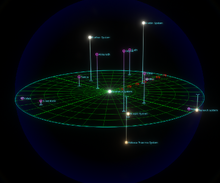
The closest stellar systems and rogue planets to the Pantheus System.
The Pantheus System is located in the Svartalfar Arm of the Via Lacrimosa galaxy. Pantheus is below the majority of galactic plane, giving bodies in the system a distinctly flat view of the galactic plane.
The closest stars system to Pantheus is the Abbaca Proxima system, at 4.14 ly away. The next nearest star systems are the Biother system (5.21 ly away) and the Biasint System (5.63 ly away), both of which have bodies with multicellular life. The closest rogue planet to Pantheus is Akkurath, at 3.06 ly away. It is close enough to the system where Cthnos and Klintriarch appear as distinct stars if viewed from its surface.

Via Lacrimosa as it appears from the Pantheus System, surrounded by globular clusters.
The nearest DSO to the system is the planetary nebula, Ghost of Sakurelle, which appears at magnitude 6.42. Other DSOs prominent in the skies of Pantheus include the Yggdrasil Nebula and Fleming 1. Given Pantheus' position relative to the galactic plane, the Via Lacrimosa's globular clusters appear densely concentrated around the galactic core. The brightest globular cluster from the Pantheus System is M 62.
System Architecture[]
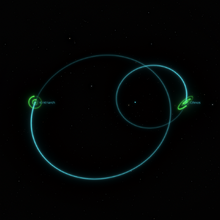
Orbits of the suns of the Pantheus System. Barycenter shown in teal.
Pantheus is a binary system, with both Cthnos and Klintriarch orbiting a central Barycenter. Both orbits intersect, and Cthnos is the inner of the two orbits, having a pericenter of 139.26 AU and an apocenter of 419.39 AU. Klintriarch's orbit by comparison has a pericenter of 263.67 AU and an apocenter of 794.07 AU. The stars orbit with a 1:1 resonance, with both stars completing an orbit every 20,283 years. Cthnos travels at 952 mph while Klintriarch travels at 1,737 mph.
Both planetary systems have significantly deviant orbital planes. The Cthnoite planetary system is angled 50° relative to the plane of the system, while the Klintriarchian planetary system is angled 230° relative to the plane of the system.
The Pantheus system has no circumbinary planets.
Governance[]
System Bodies[]
The Pantheus system has a total of 23 planets, 11 of which are around Cthnos and 12 of which are around Klintriarch. The majority of the Panthian planets are gas giants, most of which have moons massive enough to undergo hydrostatic equilibrium, and some large enough to sustain liquid cycles and atmospheres. There are a total of 65 planetary mass objects in the Pantheus System.
Cthnos[]
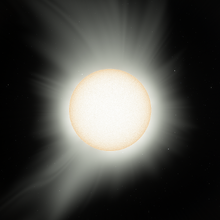
Cthnos (/kɪθnoʊs/, KITH-nos), otherwise known as Pantheus A, is a F9 spectral class star and the main body of the Pantheus System. A white class F star, Cthnos is significantly brighter than the sun and the majority of main sequence stars in the universe. Cthnos and the Cthonite system formed 1,002,200,000 ago, and is two million years younger than Klintriarch. Cthnos occupies approximately 65% of the mass of the Pantheus System. The habitable zone of the star extends around 1-2 AU and includes the orbit of Xua.
Heaphance[]
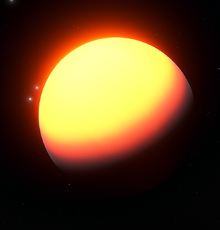
Heaphance's superheated gas envelope glows fiery colors.
The first planet from Cthnos, Heaphance (/hɛfæns/, HEH-fanss) is a gas giant world. Heaphance is primarily made of water vapor and hydrogen, with a substantial mantel and traces of helium. Despite being only the second most massive of the Cthnoite gas giants, its proximity to Cthnos renders Heaphance the largest planet in the Pantheus. Heaphance, if colder, would be a dark lavender color, but through thermal radiation it appears red and yellow. The planet is large enough to be seen as a prominent disk at the orbit of Oaven, where it can appear as large as 13 arcminutes across and as bright as the full moon. Heaphance has 23 dwarf moons, many of which are bright enough to be faintly seen as distant as the orbit of Xua.
Due to its large size and brightness, Heaphance is one of the most distinct planets of the Panthian system, and is sometimes poetically referred to as Pantheus' Third Sun. Heaphance was the first planet found and cataloged by Sylvester Arsiza, and one of his briefest researched.
Oaven[]
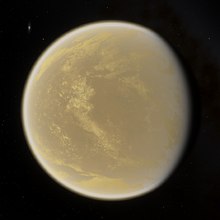
Torrid clouds sweep across Oaven's water vapor atmosphere.
The second planet from Cthnos, Oaven (/oʊeɪvɪn/, oh-AY-vin) is a torrid world, and is by far the hottest Panthian planet. Oaven is composed of a substantial mantle around an iron core. The conditions on the planet are incredibly hostile, as its with surface conditions generally exceeding 2000 °F. The surface of Oaven is mostly dark igneous rock, and is scarred by the planet's active geology. Oaven's many volcanoes contribute to its runaway greenhouse atmosphere of water vapor and carbon dioxide, which weighs on the planet with a crushing 373 atm. From space, Oaven appears bright, tan in color and is covered in cream colored clouds of carbon dioxide. Oaven has no moons, but both Heaphance and Geltrest can be seen large in the sky from the planet's orbit.
Oaven's scorching conditions have led to its reputation as a "hell planet" and a place of pain and banishment. Various missing person cases in the area have been attributed to tourist ships crashing into the planet and disintegrating in its stratosphere, though only one such incident has been officially confirmed.
Geltrest[]
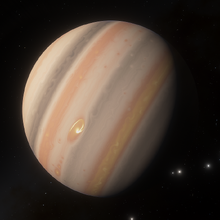
Massive storms rage among the cloud bands of Geltrest.
The third planet from Cthnos, Geltrest (/ɡɛltrɛst/, ghelt-trest) is a gas giant. Geltrest is primarily composed of hydrogen, water vapor and helium, with a small core of silicate and metal. Geltrest is the fourth largest but second most massive Cthnoite gas giant. It has the fastest rotation of any Panthian planet, with a day length of 7 hours and 27 minutes. The planet's appearance is defined by bands of brown and orange gas, which are generated by the planet's internal heat left over from accretion. Geltrest is notable as its axial tilt is 64° off the Cthnoite ecliptic, which causes the planet's gas bands to appear diagonal and exposes its polar vortexes to observation from other bodies in the plane. Gelrest has one large moon, Sauri, as well as a system of 49 small irregular moons, many of which orbit retrograde. Gelrest is large and close enough to appear as a disk around the orbits of Oaven and Xua. Given the planet's axial tilt, its moon system is also visible as a vertical association of stellar brightness bodies extending several times the diameter of the planet.
Geltrest is frequently known for its features, as a storm as the most massive inner Cthnoite planet, minor bodies which orbit inward of the orbit of Mauru are referred to as "Gelrester bodies." Geltrest's immense gravity is likely responsible for pulling Xua inward and stunting its growth, as gravitational perturbations would've prevented Xua from absorbing additional planetessimals.
Sauri[]
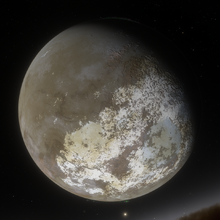
Sauri's bright white sand dunes contrast with the planet's dark mare regions.
Sauri (/saʊˌri/, SOWR-ee) is the third moon of Geltrest, and the only rounded moon of the Geltrester system. Sauri is a tidally locked desert moon. It has a small diameter, and is composed of a silicate mantle around an metallic core. The moon has a thin, brown atmosphere of sulfur dioxide with trace amounts of octane and chlorine. The surface of Sauri is split between igneous mares and rocky features on its nearside and the vast Eddenter Desert on its far side - where temperatures can rise as high as 175°F. Some volcanoes dot the Saurian surface, and then presence of canyons may indicate that the moon had liquid surface water in the distant past. Sauri's orbit on the Geltrester plane makes it a particularly easy observation for telescopes, as even minimal magnification can resolve the body distinctly from Geltrest.
Sauri, as a blistering desert world with a poisonous and thin atmosphere, is neither inhabited nor a coveted tourist destination. Strictly in-spaceship tours are offered through the planet's north pole auroras, where visitors can observe the massive form of Geltrest looming above the twilight.
Xua[]
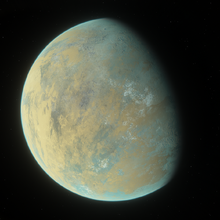
Xua's exotic atmosphere gives the planet its distinct color scheme.
The fourth planet from Cthnos, Xua (/zuːʌ/, zoo-UH) is a temperate world. Xua has a smaller diameter and is composed of a silicate mantle around a metallic core. It is the second smallest and least massive Panthian planet, after Liana. The planet has a substantial atmosphere of .8 atm, composed of nitrogen, sulphur dioxide, carbon dioxide, hydrogen sulphide and trace amounts of acetylene, ethane and carbon monoxide. The prominence of nitrogen and sulfur dioxide in its atmosphere give the planet its distinct teal appearance and cloud cover. The surface of Xua is a temperate global desert with an average temperature of 40°C, primarily sedimentary rock and sand dunes. The surface of the planet is covered in many canyons, indicating it likely used to have a water cycle. Xua was named for for the planet's prominent, X shaped Turqezia canyon. The planet has no moons.
Xua operates under the jurisdiction of the semi-autonomous Xuan Provisional Authority - a small planetary government that oversees the planet's 150 million citizens. A sprawling complex of habitats in the planet's northern hemisphere includes capital Aurora City as well as cities such as New Providence and East and West Wells. The population is entirely reliant on foreign imports for food and resources. Both planets are the fourth planets of their respective systems, are smaller desert worlds, have distinctive colors, and have been colonized.
(...)
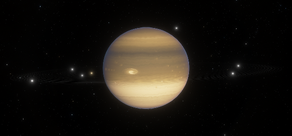
Mauru's ring system and many dwarf moons orbit the planet's golden-brown body.
Mauru[]
The fifth planet from Cthnos, Mauru (/maʊˌruː/, MOW-roo) is a gas planet. Mauru is primarily composed of hydrogen, water vapor, and helium, with a small core of silicate and metal. Mauru is the third largest but least massive Cthnoite gas giant. The planet's northern hemisphere is dominated by beige and brown clouds of hydrogen while its southern hemisphere is dominated by cream colored water vapor clouds. Mauru has a system of 73 dwarf moons, 8 of which shepherd its rings system and three of which - Lithania, Kuusa and Leones - are planetary mass objects. The Mauruan System is tilted 40 degrees on its axis, greater than that of Lanna but less than Rex Celestia and Geltrest. Mauru is the most oblate planet in the Panthian system, and has an 8 hour day.
Mauru is considered one of the most beautiful Panthian planets due to its distinct coloration and ring system. Before the system was designated a protected historical site Mauru's rings were occasionally harvested for water ice, and a number of defunct mining stations still orbit in the planet's inner rings.
Lithania[]
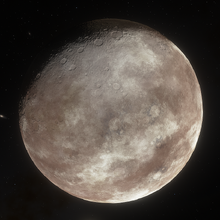
The far side of Lithania, covered in barren rock.
Lithnaia (/lɪθɑːnjʌ/, lihth-ANYUH) is the ninth moon of Mauru, and first round moon in the Mauran system. Lithania is a rocky moon, and is composed of a silicate mantle around a metallic core. The world has no atmosphere, and is the smallest and least massive of the rounded Mauran moons. The surface of the moon is dominated by craters, most notably the Misoff craters on the moon's near side. The remainder of the moon is mostly brown areas containing Tholins. Lithania is tidally locked.
Lithania is the most popular destination in the Mauran system given its proximity to Mauru and Kuusa. 10 million citizens live in the world's domed capital - the borough of Fulgur - built around the Misoff craters. The city's tourism offers merchandise ans service related to Mauru and its permanent shine upon the Lithanian nearside.
Kuusa[]
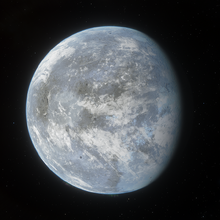
Despite its oceanic appearance, Kuusa is actually a frozen desert, plagued with volcanism and storm clouds.
Kuusa (/ku:sæ/, koo-SAH) is the tenth moon of Mauru, and the second round moon in the Mauran system. Kuusa a cold desertic moon of .07 planetary masses. It has a rather small size, and has is a metallic core marginally more massive than its silicate mantle. Kuusa is by far the most massive and largest Mauran sattelite. The moon has an atmosphere of .07 atm, composed of sulphur and carbon dioxide, with trace amounts of Krypton and Xenon. Although it appears blue, Kuusa's surface is a primarily beige and brown rocky desert, intersected by mountains and sand dunes. Due to tidal hearing, Kuusa is immensely volcanic, which is thought to be the cause of the overrepresentation of sulphur dioxide in its atmosphere.
Kuusa's hostile conditions have restricted it from ever becoming a large colony. Kuusa is most famous as observed from Lithania, where its teal atmosphere and storm clouds can be appreciated from afar.
Leones[]
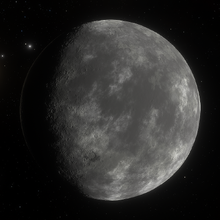
The silvery mares of Leones.
Leones (/li:oʊnɛz/, lee-ohn-ez) is the eleventh moon of Mauru, and the third round moon in the Mauran system. Leones is a rocky moon. It has a small size, and has a silicate mantle around a metallic core. The moon has no atmosphere, and is the second largest and second most massive moon of Mauru. Leones' surface is covered in igneous mares and silver rock, as well as impact craters.
Leones receives the least tourists of the Mauran system. A relatively large silvery moon, Leones shines beautifully over Fulgura. However, as Leones appears incredibly small to the naked-eye, it is generally overshadowed by the comparably massive Mauru and Kuusa.
Splent[]
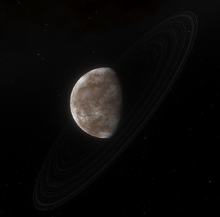
Splent and its water ice ring system.
The sixth planet from Cthnos, Splent (/splɛnt/, splehnt) is a a cold ice-glazed world. Splent has a manageable diameter, and is primarily made of a substantial water-ice crust around a mantle and metallic core. Due to the prevalence of craters on Splent, the planet is not thought to have a substantial subsurface ocean. Splent has an incredibly strenuous atmosphere of nitrogen and no moon system, but has multiple prominent rings of water ice. The icy surface of Splent is covered in splotches of brown and beige where there is a higher concentration of minerals. Many lineae in the ice are visible at a distance.
Splent receives considerable tourism due to its attractive appearance. Despite early colonization before the system was designated protected, the local administration is hosted in space stations which orbit the planet roughly seven million miles off its surface.
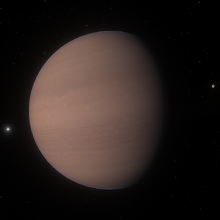
Lanna[]
The seventh planet from Cthnos, Lanna (/lænʌ/, LAN-uh) is a fridig gas giant. Lanna has a diameter of
The seven rounded moons of Lanna host the majority of the system's population, and includes system capital Bilsephina on Contressa.
